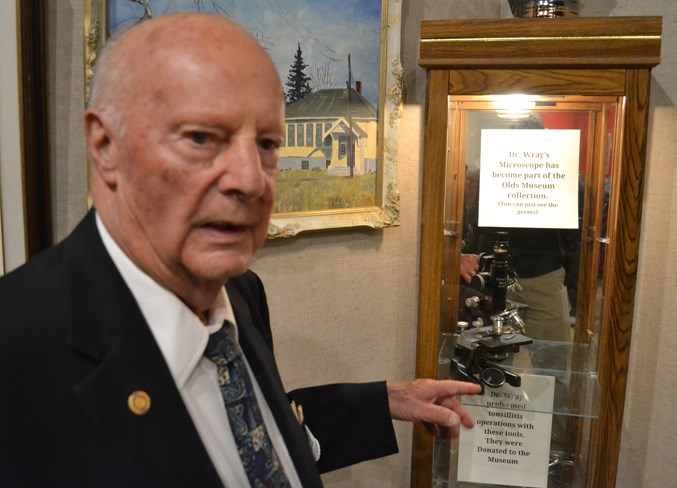At the Mountain View Museum and Archives, tucked in between several paintings currently on display by Dr. Dick Wray are several artifacts from his lengthy career.
The exhibition of Dr. Wray's paintings, which began April 2, ends May 31.
Dr. Wray, 89, retired nine years ago.
The case features a microscope, an ether mask and a bedpan.
"The bedpan's not mine," Dr. Wray said quickly as he discussed the artifacts with those who attended a reception at the museum May 16.
However, he was happy to discuss the microscope and ether mask.
"These aren't ones of mine, but they're the same things. I had a mask we used to put ether on."
He said the microscope was used a lot, especially early in his practice. He came to Olds in 1956.
"If somebody came in and had appendicitis, you did your own lab work because there were no lab techs or anything in those days," he said.
The ether mask was an object of special fascination.
"You put muslin cloth or gauze over it and you dripped ether on it to put (patients) to sleep," he said.
"If you were doing a tonsillectomy you didn't want the tube to be in the way of the surgeon. So what you did, you put the tube in through the nose and then you took that forcep and reached in the back of the throat, and put it in the windpipe — while they were asleep," he added.
"We used to have a chemical which wasn't quite as irritating as ether. Ether is very irritating. So you dripped that on. Soon as the kid was asleep, you switched to the ether because it was much safer.
"It was considered to be a safe anesthetic because all you had to do is you watched the patient's breathing and their pupils. And if their pupils started to go like this, you cut back on the ether. And If they started to breathe hard, you increased the ether. Just to keep them asleep while you took their tonsils out," he said.
"Tonsillectomies were very common in those days. This was before penicillin, so tonsillitis was a pretty serious disease. It often ended up with a big abscess in the throat and it could even be fatal."



